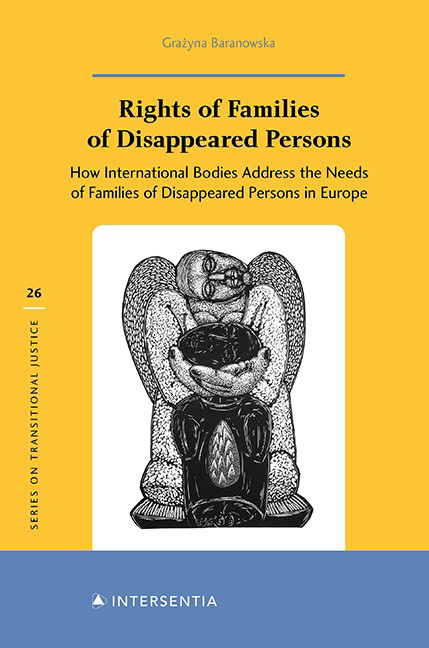Book contents
- Frontmatter
- Acknowledgements
- Contents
- List of Cases
- Chapter 1 Introduction to the Rights and Needs of Families of Disappeared Persons
- Chapter 2 The European Court of Human Rights and Disappeared Persons: Broadening in Substantiating Claims and Narrowing Down Through Application of Temporal Competences
- Chapter 3 The UN Human Rights Committee and Disappeared Persons: Approaches to the Right to Life
- Chapter 4 International Judicial Bodies Established in Response to Conflicts in the Former Yugoslavia: Addressing Mass Disappearances
- Chapter 5 Searching For and Exhuming Disappeared Persons: International Non-Judicial Mechanisms
- Chapter 6 Conclusion: Addressing Rights and Needs of Families of Disappeared Person in Europe
- Index
Chapter 3 - The UN Human Rights Committee and Disappeared Persons: Approaches to the Right to Life
Published online by Cambridge University Press: 10 December 2021
- Frontmatter
- Acknowledgements
- Contents
- List of Cases
- Chapter 1 Introduction to the Rights and Needs of Families of Disappeared Persons
- Chapter 2 The European Court of Human Rights and Disappeared Persons: Broadening in Substantiating Claims and Narrowing Down Through Application of Temporal Competences
- Chapter 3 The UN Human Rights Committee and Disappeared Persons: Approaches to the Right to Life
- Chapter 4 International Judicial Bodies Established in Response to Conflicts in the Former Yugoslavia: Addressing Mass Disappearances
- Chapter 5 Searching For and Exhuming Disappeared Persons: International Non-Judicial Mechanisms
- Chapter 6 Conclusion: Addressing Rights and Needs of Families of Disappeared Person in Europe
- Index
Summary
The Human Rights Committee (HRC) was established on the basis of Article 28 of the International Covenant on Civil and Political Rights (ICCPR, Covenant), in order to monitor the implementation of the ICPPR by the states parties. The Covenant grants the HRC competence to examine state reports (Article 40), consider interstate communications (Article 41), and – if the interstate communication is not resolved to the satisfaction of the states concerned – appoint ad hoc Conciliation Commissions (Article 42). Although the ICCPR does not directly establish a competence to issue general comments, the HRC has formulated to date 36 comments, in which the HRC interprets the obligations imposed by the Covenant on the states. Simultaneously with the ICPPR, the First Optional Protocol was adopted, which establishes the procedure of individual communications. They can be submitted by any individual (known as the ‘author’ of a communication, in essence an applicant) who claims to be the victim of a violation of the ICCPR against state parties which have ratified the Protocol. In connection with this competence the HRC is regarded as a quasi-judicial body. So far, none of the state parties to the Covenant have filed an interstate communication (Article 41 and Article 42); therefore, this instrument is omitted in the further part of the study. The presented analysis focuses primarily on the Views of the HRC in individual cases, as those are of especial relevance for families of disappeared persons. The chapter begins with a brief analysis of general comments and concluding observations to the state reports which deal with enforced disappearances.
The ICCPR does not contain specific provisions relating to enforced disappearances, but they are explicitly mentioned in the General Comment relating to Article 6 (the right to life) and Article 9 (the right to liberty and security of person) of the Covenant. In the context of the right to life, as early as in 1982, i.e. a decade before the adoption of the Declaration on the Protection of All Persons from Enforced Disappearance, the Committee pointed out that the state parties should take concrete and effective measures to prevent disappearances and create procedures enabling a thorough investigation of cases of disappearances if they occurred in circumstances in which a violation of the right to life could have taken place.
- Type
- Chapter
- Information
- Rights of Families of Disappeared Persons , pp. 111 - 132Publisher: IntersentiaPrint publication year: 2021



